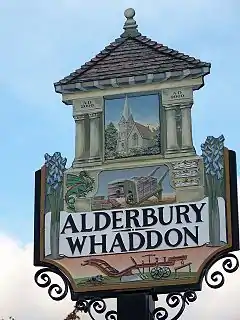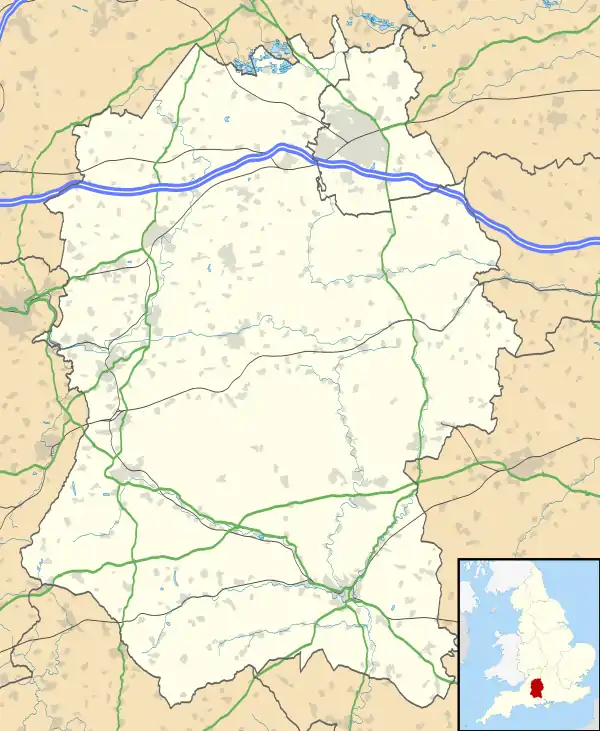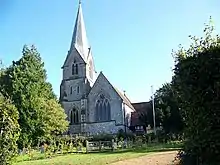Alderbury
Alderbury is a village and civil parish in Wiltshire, England, about 3 miles (5 km) southeast of Salisbury.
| Alderbury | |
|---|---|
 | |
 Alderbury Location within Wiltshire | |
| Population | 2,223 (in 2011)[1] |
| OS grid reference | SU189271 |
| Civil parish |
|
| Unitary authority | |
| Ceremonial county | |
| Region | |
| Country | England |
| Sovereign state | United Kingdom |
| Post town | Salisbury |
| Postcode district | SP5 |
| Dialling code | 01722 |
| Police | Wiltshire |
| Fire | Dorset and Wiltshire |
| Ambulance | South Western |
| UK Parliament | |
| Website | Parish Council |
The parish includes the village of Whaddon, which is adjacent to Alderbury, and the hamlet of Shute End. The River Avon forms the western boundary of the parish. The villages are on the Salisbury-Southampton road which became the A36 primary route; a bypass was opened in 1978, taking the A36 to the east of the villages.[2]
Religious sites
A church at Alderbury was recorded in the 1086 Domesday Book.[3] A new parish church of St Mary[4] was erected on the same foundations in 1857–58 to designs by S.S. Teulon, with stained glass by Henry Holiday; Clayton and Bell; Heaton, Butler and Bayne; and William Morris. The church is Grade II listed.[5] The parish had chapelries at Farley and Pitton until 1874, when the parish of Farley with Pitton was created.[6]
Although the previous church at this site (demolished in 1857) is well covered in histories of the region, there has been a place of worship here for centuries. There is mention of one in a 1341 document, and a 15th-century document discusses St John of Alwardburie. The church on this site was called St Mary's by 1754, "a plain building with a wooden turret, perpendicular windows in the chancel and a post-Restoration south porch with a belfry" according to Wiltshire Council. That was the building that was demolished in 1857.[7]
There was a church or chapel at Whaddon in the 12th to 14th centuries, which fell into disuse sometime before 1536.[8]
Not far from Alderbury, Ivychurch Priory was an Augustinian monastery established in the 12th century and dissolved in 1536. According to Historic England, "all that remains is a cylindrical pier with multi-scalloped capital and part of the double-chamfered arch with a respond to the west with a half-pier and capital; this is attached to the west wall of the church which retains one buttress".[9]
A Wesleyan Methodist chapel was built at Alderbury in 1825 and demolished in 1970.[10] A Primitive Methodist chapel built at Whaddon in 1884 became a Roman Catholic chapel in 1990.[11][12]
Notable buildings

Alderbury House is a Grade II* listed country house from the late 18th century,[13] near St Mary's church, on a hill above the Avon meadows. Described as "one of Wiltshire's most elegant Georgian country houses",[14] with a 33-acre property, it is now believed to have been designed by Benjamin Henry Latrobe, known for his work on The White House in Washington DC. The historic listing, added in 1960, had stated that the architect was James Wyatt, but it was "misattributed", according to the book The Domestic Architecture of Benjamin Henry Latrobe.[15]
At Shute End, St Marie's Grange was built in 1835 by architect Augustus Pugin for his own occupation. The house is Grade I listed.[16]
Workhouses
The Alderbury Poor Law Union built workhouses to serve the Salisbury area. One workhouse was built on Coombe Road in 1836. Another was built near the Odstock road in 1878 and later had a chapel added. The county council took over the site, renamed Meyrick Close, in the 1970s as a social services facility. [17] [18]
Notable people
In the 16th century, Ivychurch Priory was converted into a house by Henry Herbert, 2nd Earl of Pembroke. Residents included Sir George Penruddock (died 1581, politician); Mary Herbert, Countess of Pembroke (1561–1621, literary figure and patroness); and John Dove (died 1664/5, politician).
Tennis player Violet Millicent Pinckney (1871–1955) was born at Alderbury.
Canal and railways
The Salisbury and Southampton Canal was built from Kimbridge (where it joined the Andover Canal) to Alderbury but was never completed as far as Salisbury; construction stopped at Tunnel Hill, near Alderbury House. The canal was opened in 1802 or 1803 and closed in 1806.
The Bishopstoke-Romsey-Salisbury section of the London and South Western Railway was built north of Alderbury and Whaddon, turning west into the Dean valley towards Dean station at West Dean. Opened in 1847, it continues in use as part of the Wessex Main Line between Bristol and Southampton. In 1866 the Salisbury and Dorset Junction Railway was built from a junction with the earlier railway near Alderbury, skirting Whaddon and turning south towards Downton and the south coast.[19] This line was closed in 1964 and the track was lifted.
Amenities
Alderbury has a primary school, Alderbury & West Grimstead CofE (VA) Primary School (commonly abbreviated as "AWGS"),[20] which opened in 1993 on a new site to replace a building which had been used as a school since 1838.[21]
There is one pub: the Green Dragon at Alderbury, additionally a social club is situated next to the village hall in the grounds of the recreation field.
Whaddon has a post office / newsagent. Alderbury has a slightly larger local store on Canal Lane.
References
- "Wiltshire Community History – Census". Wiltshire Council. Retrieved 20 August 2015.
- "Alderbury". Wiltshire Community History. Wiltshire Council. Retrieved 20 August 2015.
- Alderbury in the Domesday Book
- "The Parish Church of St. Mary Alderbury and Whaddon". Retrieved 20 August 2015.
- Historic England. "Church of St Mary, Alderbury (1355757)". National Heritage List for England. Retrieved 20 August 2015.
- "No. 24157". The London Gazette. 1 December 1874. pp. 5992–5995.
- "Church of St. Mary, Alderbury". Wiltshire Community History. Wiltshire Council. 29 April 2018. Retrieved 5 January 2021.
- "Whaddon Church". Wiltshire Community History. Wiltshire Council. Retrieved 20 August 2015.
- Historic England. "Remains of Augustinian Priory at Ivychurch Farmhouse (1355751)". National Heritage List for England. Retrieved 7 January 2021.
- "Wesleyan Methodist Chapel, Alderbury". Wiltshire Community History. Wiltshire Council. Retrieved 20 August 2015.
- "Roman Catholic Chapel, Whaddon". Wiltshire Community History. Wiltshire Council. Retrieved 20 August 2015.
- "Chapel of the Holy Family, Whaddon". Retrieved 20 August 2015.
- Historic England. "Alderbury House (1023788)". National Heritage List for England. Retrieved 21 August 2015.
- Eight of the biggest country house sales in Britain in 2020
- Fazio, Michael W. (19 June 2006). The Domestic Architecture of Benjamin Henry Latrobe. p. 713. ISBN 0801881048.
- Historic England. "St Marie's Grange (1023953)". National Heritage List for England. Retrieved 21 August 2015.
- "Alderbury (Salisbury)". The Workhouse.
- "Salisbury: The expansion of the city; Milford Pages 90-93 A History of the County of Wiltshire: Volume 6. Originally published by Victoria County History, London, 1962". British History Online. Retrieved 16 July 2020.
- Crittall, Elizabeth, ed. (1959). "Railways". A History of the County of Wiltshire: Volume 4. London: University of London. pp. 280–293. Retrieved 16 July 2020 – via British History Online.
- "Alderbury & West Grimstead Primary School". Retrieved 21 August 2015.
- "Alderbury & West Grimstead C. of E. Primary School". Wiltshire Community History. Wiltshire Council. Retrieved 21 August 2015.
External links
 Media related to Alderbury at Wikimedia Commons
Media related to Alderbury at Wikimedia Commons- Alderbury Parish Council
- Alderbury & Whaddon Local History Research Group
- Alderbury FC
